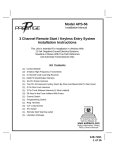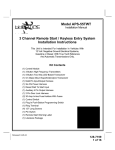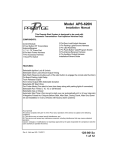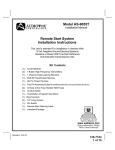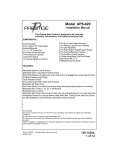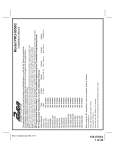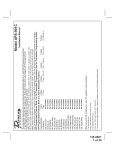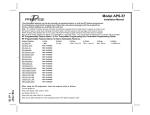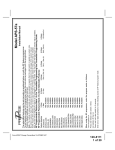Download Code Alarm ca6553sst Installation guide
Transcript
CA-610 Installation Instructions PROFESSIONAL INSTALLATION STRONGLY RECOMMENDED Installation Precautions: Roll down window to avoid locking keys in vehicle during installation Avoid mounting components or routing wires near hot surfaces Avoid mounting components or routing wires near moving parts Tape or loom wires under hood for protection and appearance Use grommets when routing wires through metal surfaces Use a voltmeter for testing and verifying circuits Kit Contents: (1) - Remote Start/Alarm Control Module (2) - Four Button Transmitters (1) - Siren (1) - Multi Pin Harness (1) - Six Pin Harness (1) - Four Pin Harness (1) - LED (1) - Valet / Programming Switch (1) - Control Switch (1) - Four Pin Shock Sensor Harness (1) - Door Lock Harness (1) - Shock Sensor (1) - Starter Inhibit Relay and Socket (2) - 30 Amp In-line Fuse Holders With Fuses (1) - Pin Switch Hardware Bag (2) - Under Hood Caution Labels (1) - Literature Package Note: Do not install this system on a vehicle that is not equipped with the following: • Automatic Transmission • Fuel Injection • Ignition / Shift Interlock Technical Support For Authorized Dealers - (800) 421-3209 FCC COMPLIANCE This device complies with Part 15 of the FCC rules and with RSS-210 of Industry Canada. Operation is subject to the following two conditions: 1. This device may not cause harmful interference, and 2. This device must accept any interference received, including any interference that may cause undesired operation. Warning! Changes or modifications not expressly approved by the party responsible for compliance could void the user’s authority to operate the equipment. 128-6531 1 of 24 INSTALLATION OF THE MAJOR COMPONENTS: Control Module: Select a mounting location inside the passenger compartment (behind the dashboard). The mounting location selected must be within 24" of the ignition switch wiring harness to allow connection of the 6-pin harness. Be certain that the chosen location will not interfere with the proper operation of the vehicle. Avoid mounting the module to or routing the wiring around the steering shaft/column, as the module or wiring may wrap around or block the steering wheel preventing proper control of the vehicle. Secure the module in the chosen location using cable ties or screws as necessary. Do not mount the module in the engine compartment, as it is not waterproof. SIREN: Select a location in the engine compartment that is not accessible from below the vehicle. The selected location must be clear of hot or moving parts within the engine compartment The siren must be pointed downward to prevent water retention and the flared end must be pointed away from and out of the engine compartment for maximum sound distribution. Before securing the siren, check behind your chosen location to assure that the mounting screws will not penetrate any factory wiring or fluid lines. Secure the siren mounting bracket using #8 self taping screws or by first using the mounting bracket as a template, scribe or mark the mounting holes. Drill the marked holes using a 1/8" drill bit, then mount the siren using #8 sheet metal screws. Hood Pin Switch: The pin switch included in this package is required for the safety shut down of the Remote Start system. If the vehicle is being serviced, this hood switch prevents the Remote Start activation even if the transmitter is operated. This switch MUST be installed in all applications. Failure to do so may result in personal injury or property damage. Mount the switch in an area under the hood that is away from water drain paths. If necessary, the included brackets may be used to move the switch away from rain gutters or allow mounting to the firewall behind the hood seal. In either case the switch must be set to allow the hood door to depress the switch at least 1/4" when the hood is closed and fully extended when the hood is opened. For direct mounting, a 1/4" hole must be drilled. Carefully check behind the chosen location to insure the drill will not penetrate any existing factory wiring or fluid lines. Drill a 1/4" hole in the desired location and thread the pin switch into it. If using the mounting bracket, first secure the bracket to the desired location and secure the pin switch in the threaded mounting bracket hole. DASH MOUNTED LED: The small Red LED included in the kit will serve as a visual indicator of the alarm's status and provide a visual deterrent to a potential thief. The LED also provides important feed back information during the transmitter and feature program modes. The LED should be installed in the dash in an area highly visible so that it may be seen from the driver's seat as well as from outside the vehicle. Inspect behind the chosen location to insure that the drill will not penetrate any existing factory wiring or fluid lines. Carefully drill a 1/4" hole in the desired location and pass the connector end of the LED through the hole and toward the control module. Press the LED firmly into place until it is fully seated in the mounting hole. THE RECEIVER/ANTENNA ASSEMBLY: The Superheterodyne Receiver Antenna Assembly provided with this system allows routing from below the dashboard for maximum operating range. Choose a location above the belt line (dashboard) of the vehicle for best reception. Special considerations must be made for windshield glass as some newer vehicles utilize a metallic shielded window glass that will inhibit or restrict RF reception. In these vehicles, route the antenna toward a rear window location for best reception. Secure the antenna with double stick tape provided. After securing the antenna with tape, we advise also securing a section of the antenna cable to a fixed support. 2 128-6531 2 of 24 This will prevent the antenna from dropping down in case the double stick tape is exposed to extreme heat, which may loosen its gummed surface. Route the 3 pin connector toward the control module using caution not to pinch the cable as this will cause poor or no RF reception to the control module. VALET/PROGRAM/MANUAL OVERRIDE SWITCH : Select a mounting location that is easily accessible to the operator of the vehicle. It is not necessary to conceal the switch. However, concealment is recommended as it offers a higher level of security. The switch can be mounted to the lower dash panel in the driver's area. Inspect behind the chosen location to insure that adequate clearance is allowed for the body of the switch, and also that the drill will not penetrate any existing factory wiring or fluid lines. Drill a 5/32" hole in the desired location and mount the switch by passing it through the panel from the underside. Secure the switch using the nut and star washer. Route the switch's connector toward the control module. NOTE: During the program sequence, there are times when this switch and the ignition switch will be used simultaneously. We recommend that the push-button switch be mounted on the left side of the ignition switch to facilitate this operation. SAFETY (Red Handled ) CONTROL SWITCH: Select a mounting location that is within reach of the ignition switch, as this switch, in combination with the ignition switch and brake, will be used to program the certain features of the system. It is suggested that the switch be mounted to the lower dash panel in the driver's area. Inspect behind the chosen location to insure that adequate clearance is allowed for the body of the switch, and also that the drill will not penetrate any existing factory wiring or fluid lines. Drill a 1/4" hole in the desired location and mount the switch by passing it through the panel from the underside. Secure the switch using the nut, star washer, and ON/OFF face plate. It is best to install the switch to allow the ON position to be up toward the driver and the OFF position to be down or away from the driver. Route the switch wires toward the control module. SHOCK SENSOR: Select a centrally located, solid mounting surface for the shock sensor that will allow consistent operation from all areas of the vehicle. The selected location must be within 18" of the control module to allow routing and connecting of the 4 pin harness. Secure the shock sensor to the chosen location using two #8 self taping sheet metal screws. The sensor can also be secured to an existing dash brace using cable tie straps. Whichever mounting method is used be sure to allow access to the sensitivity adjustment potentiometer for use later in the installation. STARTER KILL RELAY: Select a mounting location within 12" of the ignition switch's low current start solenoid wire. Secure the relay to an existing harness in the chosen location using a cable tie around the relay's wiring harness. Caution! Do not wire tie the metal bracket to an existing wiring harness as vibration may cause chaffing and shorting damaging the factory wiring. If an existing harness is not available then secure the relay's metal mounting tab to an under dash metal brace with a #8 self taping sheet metal screw. Wire the relay as per the diagram found later in this manual. The CA-610 is to be used in vehicles with AUTOMATIC TRANSMISSIONS only! Although this is a sophisticated system with many advanced features, IT MUST NOT be installed into a vehicle with a manually operated transmission. Doing so may result in serious personal injury and property damage. 3 128-6531 3 of 24 WIRING THE 6 PIN HARNESS: RED w/ VIOLET: +12 volts Connect this wire to a +12 Volt constant source found at the vehicle's ignition switch using the 30 Amp fuse and holder provided. This wire provides power for the control circuit as well as the ignition 1 and ignition 2 relays. RED: +12 Volts Connect this wire to a +12 Volt constant source found at the vehicle's ignition switch using the 30 Amp fuse and holder provided, but NOT the same vehicle wire as used by the Red/Violet wire above. Most vehicles have more than one battery source supplying power to the ignition switch. Separate feed wires must be used for the Red and Red/Violet wires. If your vehicle does not have two battery feed wires at the ignition switch then it is possible to connect both wires to the vehicle's battery. This wire provides power for the start relay and the accessory relay. IMPORTANT! It is the responsibility of the installing technician to determine the load factor of the vehicles electrical circuits when the vehicle is running and to adequately fuse the two power wires based on that load. VIOLET: Starter Output This wire will have +12 volts when the ignition switch is turned to the START (crank) position only. This wire will have 0 volts in all other ignition switch positions. PINK: Ignition 1 Output Connect this wire to the ignition 1 wire from the ignition switch. This wire will show +12 volts when the ignition key is turned to the to the ON, RUN and START positions, and will have 0 volts when the key is turned to the OFF and ACCESSORY positions. For Diesel Applications, this wire must be connected to the ignition circuit that powers the glow plugs if the vehicle requires glow plug pre-heating. (See selectable feature #8) PINK w/ WHITE: Ignition 2 Output Connect this wire to the ignition 2 wire from the ignition switch. This wire will show + 12 volts when the ignition key is turned to the ON or RUN position and is some cases the START position. This wire will show 0 volts when the key is turned to the OFF and ACCESSORY positions. NOTE: See programming information concerning this wire to function as a ACCESSORY wire. ORANGE: Accessory Output Connect this wire to the Accessory wire from the ignition switch. This wire will show + 12 volts when the ignition switch is turned to the ACCESSORY, ON and RUN positions, and will show 0 volts when the key is turned to the OFF and START positions. 4 128-6531 4 of 24 ORANGE PINK RED/VT RED VIOLET PINK/WHITE Blue/Black Active Output 5 128-6531 5 of 24 WIRING THE 18 PIN HARNESS: White w/ Red: Parking Light Polarity This wire is the common contact of the on board parking light flasher relay. If the vehicle you are working on has +12 volt switched parking lights, connect this wire to a fused +12 volt source. (Max. 15 Amps) NOTE: If the vehicle's parking lights are ground switched, connect this wire to chassis ground. White: Parking Light Flasher Output This wire is the normally open contact of the on board parking light flasher relay. Connect this wire to the vehicle parking light feed wire. See diagram below for details on wiring positive switched parking light circuits. Parking Light Wiring Detail Black w/ Red: (+) Siren Output This is the positive siren feed wire. Route this wire through a grommet in the firewall to the siren location. Connect the Black/Red wire to the Red wire of the siren. Secure the Black wire of the siren to a known chassis ground or solid clean metal surface. Siren Wiring Detail SIREN RE D TO BLACK W/RED WIRE OF MODULE l B LA C K (-) TO VEHICLE'S CHASSIS GROUND 6 128-6531 6 of 24 Purple: (+) Door Trigger Input If the vehicle's door courtesy light switches + 12 volts when the door is opened, (Some Ford and some Import), you must connect this wire to the positive output from one of the vehicle's door pin switches. In most cases, the Purple wire will need to be connected to only one door switch no matter how many doors the vehicle has as most door lighting circuits are wired in parallel. Note for vehicles with interior delay lighting see programming under title "Completing The Installation". Green: (-) Door Trigger Input If the vehicle's door courtesy light switches to Ground when the door is opened, you must connect this wire to the negative output from one of the vehicle's door pin switches. In most cases, the Dark Green wire will need to be connected to only one door switch no matter how many doors the vehicle has as most door lighting circuits are wired in parallel. Note for vehicles with interior delay lighting see programming under title "Completing The Installation". BLUE w/BLACK: Active output This wire provides a 300mA ground output that becomes active 3 seconds before the Remote Start system initializes, and remains grounded while running plus an additional 4 seconds after the Remote Start system turns off. In all of the applications described below, a relay will be required. The Blue/Black wire can be used to accommodate the following situations: 1. Ignition 3 Output: Some newer vehicles use a third ignition wire which is required to start and keep the vehicle's engine running. If this is the case, connect the Blue/Black wire to terminal #86 of an external relay. Connect terminal # 30 & # 85 to a fused + 12 volt battery source rated for a minimum of 25 Amp. Connect terminal # 87 to the third ignition wire in the vehicle. 2. Transponder Key Override: To bypass the system while the vehicle is operating under the control of the Remote Start system. Connect the Blue/Black wire to the NEG trigger input of the accessory bypass. BLACK/GRAY: Diesel Wait To Start For Diesel glow plug preheat circuits, this Wait To Start input will allow the ignition to keep the glow plugs active for the vehicles automatic time out period before cranking the starter motor. If the BLK/GRY is connected to the glow plug wire, this will take precedence over the timing setting and the Gas/Diesel programming in the feature programming chart. Use this wire if you do not want to set the timing of the glow plug preheat circuit as shown in the feature programming chart. 7 128-6531 7 of 24 Black w/ White: Illuminated Entry Output This wire provides a 30 second ground output (300 mA Max.) whenever the remote is used to disarm the system or to unlock the doors and provides a continuous pulsed output whenever the system is triggered. This wire should be connected to an external relay, and wired to the vehicles interior entry lighting whenever the optional Interior Illumination circuit is desired. See below for relay wiring details. Black w/White trace GREY: Hood Pin Input (-) Connect the GREY wire to the hood pin switch provided . This wire will be routed through the firewall into the engine compartment. It is necessary to use an existing grommet when passing wires through the firewall to prevent short circuiting. This is an important safety feature of CA-610, and failure to use this feature can result in serious injury. Route the wire to the pin switch and connect it using the bullet connector provided. 9 128-6531 8 of 24 Orange: Ground When Armed Output This wire provides a 300mA ground output when the alarm is armed to control the starter kill relay. Connect the Orange wire to terminal #86 (orange wire) of the relay provided. Connect terminal #85 (red wire) of the relay to an ignition wire in the vehicle that is +12 volts when the ignition switch is turned to the ON and START positions and off when the key is OFF. Locate and cut the low current start solenoid wire found at the vehicles ignition switch harness. This wire will have + 12 volts when the ignition key is moved to the START (crank) position and will have 0 volts in all other key positions. Connect one side of the cut wire to terminal #87a (Black wire) of the relay. Connect the other side of the cut wire to terminal #30 (White/Black wire) of the relay. See below for detail of wiring, also see Violet Start wire detail for connection to vehicle considerations. Black White/Black Brown: Positive Brake Input Any time +12 Volts is applied to the Brown wire, the system will stop operating, even if the signal is received from the transmitter. If the brake light switch in the vehicle switches +12 Volts to the brake light circuit, connect the Brown wire to the output of the brake light switch. If the brake light switch in the vehicle switches ground, do not use the Brown wire; see Grey w/ Black wire. 10 128-6531 9 of 24 BLACK: Chassis Ground Source Connect the Black wire to a known vehicle ground source or to a solid clean metal part of the chassis. Be certain to remove any paint or grease and secure this wire with a self taping screw and ring terminal. VIOLET/WHITE: Tach Sensor Input This wire will continually monitor the engine tach rate while the vehicle is under power of the Remote Start system. This wire will be routed to the vehicle ECM tach input or through the firewall into the engine compartment and connect to the negative side of the ignition coil. This Remote Start system learns the tach rate of the vehicle and in most cases will operate properly from one multi coil pack regardless of the number of cylinders. If the vehicle has a single coil system for each cylinder, it may be necessary to connect this wire to more than one coil for proper tach reference. Shown in the feature programming chart. TAN: Delayed 300mA Pulsed Channel 3 Output The Tan wire supplies a 300mA ground pulsed output whenever channel three of the receiver is accessed. Pressing the pre-programmed transmitter button for 3 seconds will access channel 2. This is a low current output and must be connected to a relay to supply power to the trunk release or the circuit you wish to control. Connect the TAN wire to terminal # 86 of a VF45F11 P&B relay or equivalent. Connect terminal # 85 of the relay to a fused + 12 volt source. Connect the common, normally open, and normally closed contacts of the relay to perform the selected function of channel 3. See below for relay wiring detail. Tan Wire Channel 3 Relay Wiring Detail 11 128-6531 10 of 24 RED/WHITE: 300mA Latched Channel 4 Output The Red/White wire supplies a 300mA switched output whenever channel 4 of the system is accessed. Pressing the pre-programmed transmitter button will access channel 4 and will remain active, for up to 8 seconds, as long as the transmitter button is held. This is a low current output and must be connected to a relay to supply power to the device you intend to control. Connect Red w/White Trace wire to terminal #86 of a 30 Amp automotive relay or equivalent. Connect terminal #85 of the relay to a fused + 12 volt source. Connect the common, normally open, and normally closed contacts of the relay to perform the selected function of the channel 4 output. DARK BLUE: External Trigger Input The Dark Blue wire allows the Remote Start system to be activated from an external source. The intent of this wire is to allow the system to be controlled from a "POSSE/CAR-LINK" paging system or similar device. When this wire receives a ground pulse, the system will start the vehicle. BROWN/BLACK : 300 mA Horn Output The Brown/Black wire is provided to honk the vehicle’s horn. This is a transistorized low current output, and should only be connected to the low current ground output from the vehicle’s horn switch. If the vehicle uses a +12 VDC horn switch, then connect the Brown/Black wire to terminal 86 of the 30 Amp automotive relay, and connect relay terminal 85 to a fused + 12 VDC battery source. Connect relay terminal 87 to the vehicle’s horn switch output, and connect relay terminal 30 to a fused + 12 VDC battery source. WIRING THE 4 PIN HARNESS: This harness provides low current outputs to control various functions in the vehicle during different stages of the Remote Start system's operation. Understanding these outputs and the time in which they occur will allow you to determine if they are needed for the particular vehicle you are working on, as well as how to use them. GREEN/BLACK Pulsed Ground Output Before Start The Green w/Black wire will provide a 1 second 300mA pulsed ground output 1.5 second before the Remote Start system activates as well as when the transmitter is used to unlock/disarm the system. Typical use for this output would be to disarm a factory theft deterrent system to prevent false triggering of the factory alarm when the remote start system engages. BLUE: Pulsed Ground Output After Start The Blue wire will provide a 1 second 300ma pulsed ground output after the vehicle is started under control of the Remote Start system. Typically this wire will be used to re-lock the vehicle doors if the doors unlock automatically when the factory anti-theft system is disarmed. BLACK/RED Pulsed Ground Output After Shutdown The Black w/ Red wire will provide a 1 second 300 mA pulsed ground output after the Remote Start system shuts down. This output will occur regardless of whether the circuit times out or is manually terminated. Typically this output will be used to re-lock the vehicle doors if the doors unlock automatically when the ignition circuit transitions to off. BLACK/YELLOW: Ground Output During Start (Crank) The Black w/ Yellow wire will provide a 300mA ground output while the starter output of the Rremote Start system is active. This output can be used to activate the Bulb Test wire found in some GM vehicles. 12 128-6531 11 of 24 2 Pin Control Switch: (Red Connector) The Black & Black/White wires loaded in the two pin red connector enable the operation of the Remote Start system. When the Black w/ White wire is grounded, the Remote Start system is operable. When this wire is open from ground, the Remote Start is disabled. Route the twin lead Black & Black/ White wires from the control switch to the Remote Start system and plug red two pin connector into the mating red two pin connector shell of the control module. 4 Pin Shock Sensor: (White Connector) The Red (+12 volt), Black (ground), Blue (pre-detect) and Green (full trigger when armed) wires loaded into the white connector shell are the inputs/outputs of the shock sensor. Route the 4 wire harness from the shock sensor to the system and plug the 4 pin white connector into the mating 4 pin connector shell of the control module. 2 Pin LED Harness: (White Connector) The Red & Blue wires loaded into the two pin mini white connector control the anode and cathode of the dash mounted LED. Route the twin lead Red and Blue wires from the LED to the system and plug the two pin connector into the mating white mini connector. 2 Pin Valet/Program/Override Push-Button Switch: (Blue Connector) The Black & Grey twin lead wires loaded in the two pin blue connector are the ground supply and program/valet/ override input of the system. When the Grey wire is grounded, under certain conditions, the system will enter the valet mode. When the Grey wire is sequentially grounded under other conditions, the system will enter the various program modes. Route the twin lead Black and Grey wires from the valet/Program switch to the Remote Start system and plug the two pin connector into the mating blue connector. Refer to the remote programming, feature programming and function programming shown later in this installation guide for operation of the valet/ program switch. 3 Pin Antenna/Receiver Connector: (White Connector) Plug the previously routed three pin connector from the antenna receiver assemble into the mating connector of the control module. This connector supplies 12 volts, ground and RF data from the antenna receiver to the remote start module. Be certain this connector is firmly seated making good contact to the control system. 3 Pin Door Lock/Unlock Harness: (White Connector) The Blue and Green wires will provide either a pulsed ground output to the factory door lock control relay, or a pulsed +12 volt output to the factory door lock control relay. In either case, the maximum current draw through these outputs must not exceed 300mA. The Blue/Red wire will provide a pulsed ground only, and will only provide an output when the unlock button of the transmitter is pressed a second time after a first unlock command was issued. This is used for second step unlock or all doors unlock in a two step circuit. In this arrangement, BLUE is used to control the drivers door unlock relay, and the Blue w/Red will be used to control unlock of all other doors. 13 128-6531 12 of 24 3 Wire Ground Switched Door Lock Circuits: In this application, the Green wire of the door lock harness provides a ground pulse during the arming sequence, or pulsed ground lock output. Connect the Green wire to the low current ground signal wire from the factory door lock switch to the factory door lock relay. The Blue wire of the door lock harness provides a ground pulse during the disarming sequence, or pulsed ground unlock output. Connect the Blue wire to the low current ground signal wire from the factory door unlock switch to the factory door unlock relay. See Below For Wiring Detail. Blue Green 3 Wire Positive Switched Door Locks: In this application, the GREEN wire of the door lock harness provides a + 12 volt pulse during the disarming sequence, or pulsed 12 volt unlock output. Connect the GREEN wire to the low current 12 volt signal wire from the factory door unlock switch to the factory door unlock relay. The BLUE wire of the door lock harness provides a + 12 volt pulse during the arming sequence, or pulsed 12 volt lock output. Connect the BLUE wire to the low current 12 volt signal wire from the factory door lock switch to the factory door lock relay. See Below For Wiring Detail. Blue Green + Unlock Wire 3 Wire Ground Switched 2 Step Door Locks In this application, the GREEN wire provides a ground pulse during arming. Connect the this wire to the wire that provides a low current ground signal from the factory door lock switch to the factory door lock control relay. The BLUE wire provides the first ground pulse during disarming. Connect this wire to the drivers door unlock relay that requires a low current ground signal to unlock only the drivers door. If the vehicle does not have a separate drivers door relay, one will have to be added. Locate the drivers door unlock motor wire and cut it at a convenient location to allow wiring of an optional relay. Connect the door side of the cut wire to terminal 30 of the optional relay added. Connect the vehicle side of the cut wire to terminal 87a of the optional relay added. Connect the green wire of the 3 pin harness to terminal 86 of the optional relay added. Connect terminal 85 of the optional relay added to a fused constant + 12 volt source. Most vehicles door lock/unlock motor wire rest at ground, and switch +12 volts to the door lock/unlock motor wire for operation, if this is the case in the vehicle you are working on, connect the remaining terminal, 87, to a fused + 12 volt source. In the rare instance that the vehicle door lock/unlock motor legs rest at + 12 volts and switches ground to the door lock/unlock motors, connect the remaining terminal, 87, to chassis ground. 14 128-6531 13 of 24 The Blue/Red wire provides a pulse ground output when the unlock button of the transmitter is pressed a second time after disarming. Connect the Blue/Red wire to the wire that provides a low current ground signal from the factory door unlock switch to the factory door unlock control relay. 3 Wire Positive Switched 2 Step Door Locks Green Blue/Red Blue The BLUE wire provides a positive pulse during arming, or the pulsed + 12 volt lock output. Connect the green wire to the wire that provides a low current positive signal from the factory door lock switch to the factory door lock control relay. The GREEN wire provides a positive pulse during disarming, or the drivers door pulsed positive unlock output. Connect this wire to the drivers door unlock relay that requires a low current positive signal to unlock only the drivers door. If the vehicle does not have a separate drivers door relay, one will have to be added. Locate the drivers door unlock motor wire and cut it at a convenient location to allow wiring of an optional relay. Connect the door side of the cut wire to terminal 30 of the optional relay added. Connect the vehicle side of the cut wire to terminal 87a of the optional relay added. Connect the red wire of the 3 pin harness to terminal 86 of the optional relay added. Connect terminal 85 of the optional relay added to chassis ground. Most vehicles door lock/unlock motor legs rest at ground, and switch +12 volts to the door lock/unlock motor wire for operation, if this is the case in the vehicle you are working on, connect the remaining terminal, 87, to a fused + 12 volt source. In the rare instance that the vehicle door lock/unlock motor wire rest at + 12 volts and switches ground to the door lock/ unlock motors, connect he remaining terminal, 87, to chassis ground. The Blue/Red wire provides a pulse ground output when the unlock button of the transmitter is pressed a second time after disarming. Because the vehicle you are working on requires a positive pulse from the factory door lock switch to the factory door lock control relay, you will have to add a relay to invert the output polarity of this wire. Connect the Blue/Red wire to terminal 86 of the optional added relay. Connect terminal 85 & 87 to a fuse + 12 volt source. Connect terminal 30 to the low current door unlock wire from the factory door switch to the door unlock control relay. 15 128-6531 14 of 24 Blue Blue/Red Blue ALARM SELECTABLE FEATURES: NOTE: The Alarm Selectable Features and Remote Start Selectable Features programming steps following are based on transmitter button 1 being programmed for channel 1 and transmitter button 2 being programmed for channel 2. PROGRAMMABLE FEATURES: Feature Selection 1 Chirp 2 Chirps 3 Chirps Default 1. Door L/UL 1 Sec. 3.5 Sec. 1 Sec L, Dbl. U/L 1 Sec. 2. Accy Lock Auto Lock On Auto Lock Off Auto Lock Off Auto Off Auto UL Off 3. Accy. UL Auto UL Dr Auto UL All 4. Passive Locks Passive Active Active 5. Passive/Active Arm Passive Arm Active Arm Active Arm 6. Siren/Horn Siren/Horn Siren Only Horn Only Siren/Horn 7. Horn Chirp 10mS 16mS 30mS 16mS 8. Override Method Custom Code Valet Valet 9. Two Step Unlock On Off Off 10. Chirp Delete On Off Off 16 128-6531 15 of 24 To program these selectable features: Turn ignition ON press and release the valet switch 3 times. The system will chirp 1 time and the LED will flash once. Within 3 seconds, turn ignition OFF. The system will sound a short chirp, then 1 long chirp 1. Turn the ignition key to the ON position. 2. Press and release the program switch 3 times. The siren will chirp 1 time and the LED will flash once. 3. Immediately turn the ignition key OFF. The siren will sound a short chip and then 1 long chirp. 4. Use the program switch to advance to the feature that you want to change. 5. Press the LOCK button to change the selection of the programmable feature. Note : Once you enter the feature programming mode, do not allow more than 15 seconds to pass between steps, or the programming will be terminated. REMOTE START SELECTABLE FEATURES: Feature Lts Flash 1X Lts Flash 2X 1. Start Chirps Off On 2. Run Time 5 Min. 10 Min. 3. Park Lights On Flash 4. Tach Mode Tachless Tach Lts Flash 3X Lts Flash 4X Default 15Min. 20 Min. 10 Min On On 5. Voltage Level > .5V B4 start < .5V B4 start > 0.5 6. Ign. 2 Off during start On during start On 7. Diagnostics Off On 8. Start Time 0.8Sec 1.0 Sec 1.5 Sec 9 Gas/Diesel Diesel 10 Diesel 15 Diesel 20 Off 2.0 Sec 1.0 Gas To Program The Remote Start Selectable Features: 1. Turn the ignition key to the ON position. 2. Press and release the valet/program switch 3 times. 3. Immediately turn the ignition key OFF then press transmitter trunk/key button for 1 second. 4. Immediately turn the ignition key back ON.. 5. Press and release the valet/program switch 2 times. The siren will emit 2 short and 1 long chirp verifying you are in the feature program mode. 17 128-6531 16 of 24 6. Use the lock/arm button on the transmitter to advance to the feature you want to change. EXAMPLE- If you need to change selectable feature 3, press and release the lock/arm button on the transmitter 3 times in succession. The parking lights will flash, and the siren will chirp 3 times confirming that selected feature 3 can be changed. 7. Use the trunk/key button on the transmitter to change the selection of the programmable feature. If you are not sure what the setting for any feature is, press the trunk/key button one time, the parking lights will flash 1, 2, 3 or 4 times indicating the features setting. NOTE: Once you've entered the program mode DO NOT allow more than 15 seconds to pass between steps, or the programming mode will be terminated. TACH PROGRAMMING: The Remote Car Start will learn the tach rate of most vehicles single ignition coils, multiple coil packs, and or single injector. To learn tach: 1. Turn the ignition key to the ON position. 3. Press and release the program switch 3 times. . 4. Immediately turn the ignition key OFF. 5. Hold the program switch ON, then start the vehicle using the ignition key. 6. When the unit senses the tach signal, the parking lights will begin to flash. 7. Release the program switch. The parking lights will turn on for 3 seconds to indicate that the tach signal is stored and the unit is now out of the program mode. DIAGNOSTICS: 1. Be sure that programmable feature number #7 is set to the "Diagnostics On" mode. 2. Press and hold the program switch on, then turn the ignition key to the ON position. 3. The lights will flash and the number of flashes will indicate the reason for shutdown on the last remote start attempt. The indications are as follows. 1 Flash 5, 10, 15, or 20, minute run timer expired. 2 Flashes Low or No tach signal received. 3 Flashes Positive or Negative input shut down. 4 Flashes Control switch was moved to OFF position. 5 Flashes RF Shutdown command received. 6 Flashes High RPM signal over speed shut down. 7 Flashes Tach has NOT learned. 18 128-6531 17 of 24 TESTING YOUR INSTALLATION: CAUTION!! The following procedure must be performed after the installation of an Remote Start system. It is the responsibility of the installing technician to complete these tests. Failure to test the system in the following manner may result in personal injury, property damage, or both. HOOD PIN SAFETY SHUT DOWN: To test the integrity of this circuit: 1. With the drivers window in the down position, start the vehicle using the keychain transmitter. 2. Reach inside the car and pull the hood release. 3. Raise the hood and confirm that the remote start system shuts down. If the system fails this test, recheck your hood pin switch connection to the Gray/Black wire of the Remote Start system. DO NOT RELEASE THIS VEHICLE TO THE CONSUMER UNTIL YOU CONFIRM THE OPERATION OF THE HOOD PIN SAFETY SHUT DOWN FEATURE. MANUAL SHUT DOWN / ENABLE CIRCUIT: The intention of the manual shut down / enable circuit is to allow the vehicle operator to prevent operation of the Remote Start system regardless of the transmitter operation.To test the integrity of the manual shut down / enable circuit: 1. Place the control switch in the ON (Closed To Ground) position. 2. Start the vehicle using the transmitter. 3. The vehicle should start and run under the control of the remote start system. 4. Move the switch to the OFF (Open From Ground) position, the vehicle should shut OFF. If the unit fails this test, recheck your switch connection to the Ground and the Black/White wire of the Remote Start system. DO NOT RELEASE THIS VEHICLE TO THE CONSUMER UNTIL YOU CONFIRM THE OPERATION OF THE MANUAL SHUT DOWN / ENABLE FEATURE. NEUTRAL START SAFETY TEST: The intent of the neutral start switch is to prevent the vehicle from starting while the gear selector is in any position other than Park, or Neutral. When installing a Remote Start system, it is imperative that the Violet Starter wire be connected to the ignition switch side of the Neutral safety switch. To test the integrity of the Neutral Safety Circuit: 1. Set the vehicle parking brake. 2. Block the drive wheels to prevent vehicle movement. 3. Temporarily disconnect the Brown/Red positive shut down wire from the vehicle's brake switch. 4. Sitting in the vehicle, start the engine using the vehicle's ignition key. 5. Step on the brake pedal and shift the gear selector into reverse. 6. Do not move the gear selector just turn the ignition switch off. DO NOT attempt to remove the key. 7. Keeping the brake pedal depressed, activate the RF transmitter in an attempt to start the vehicle. The car should not start. 10 19 128-6531 18 of 24 8. Repeat the above test, but this time move the gear selector to the drive position. If the system attempts to start, failing this test, check the Violet wire connection. This wire must be connected to the ignition switch side of the Neutral saftey switch. If the vehicle you are working on does not have an electrical Neutral Safety switch, it will be necessary to reconfigure the Remote Start wiring to accommodate this vehicle. COMPLETING THE INSTALLATION: 1. If you have not done so already, place the red rubber handle cover over the handle of the control switch for ease of identification. This will allow your customer to distinguish the Remote Start control switch from the program switch. 2. Mount the control module up and behind the dash securing it in place with cable ties or screws. Be certain that the mounting location will not inhibit any of the controls of the vehicle. 3. Securely tie all wiring up and away from all hot and moving parts that they may come in contact with under the dash board or in the engine compartment areas. CAUTION: Avoid the area around the steering shaft and column, as wires can wrap around these mechanisms and inhibit the safe operation of the vehicle. 4. Apply the Caution labels supplied with this kit to a conspicuous area in the engine compartment. Make sure to clean the surface before affixing the label. 5. Check the vehicle's wipers, lights, horn, etc.... to insure proper operation. 6. Replace all panels that were removed during installation, and retest the system. 7. Explain all activated features and safety systems associated with Remote Start system installed to the customer. 8. Place the Remote Start Control Switch Tag on their respective switch and point these out to the customer. 20 128-6531 19 of 24 PROGRAMMING TRANSMITTERS: It is important to remember that during the programming mode, each individual step must be completed within 15 seconds of the previous step. If the 15 second time limit expires between steps, the system will automatically exit the program mode. This is indicated by a long chirp from the siren. TO PROGRAM ADDITIONAL TRANSMITTERS: 1. Enter the vehicle, and turn the ignition switch to the ON position. 2. Press and release the valet push button switch 3 times. 3. The dash mounted LED will flash 1 time, and the siren will chirp 1 time, indicating that the system is ready to accept programming of channel #1 which is arm/lock. 4. Press and hold the LOCK symbol button of the transmitter you wish to program for 4 seconds or until a long chirp is heard from the siren. "Repeat step 4 for each transmitter you wish to program" 5. Press and release the valet push button switch 1 time to advance to Unlock. The siren will chirp 2 times and the dash mounted LED will Flash 2 times, indicating that the system is ready to accept programming for channel # 2 which is for disarm/unlock 6. Press and hold the unlock symbol button of the transmitter you wish to program for 4 seconds or until a long chirp is heard from the siren. "Repeat step 6 for each transmitter you wish to program" 7. Press and release the valet push button switch 1 time to advance to channel 3. The siren will chirp 3 times and the dash mounted LED will Flash 3 times, indicating that the system is ready to accept programming for channel # 3 which is the trunk release and start output channel of the system. 8. Press and hold the trunk/key symbol button of the transmitter you wish to program for 4 seconds or until a long chirp is heard from the siren. "Repeat step 8 for each transmitter you wish to program". 9. Press and release the valet push button switch 1 time to advance to channel 4 if so equipped. The siren will chirp 4 times and the dash mounted LED will Flash 4 times, indicating that the system is ready to accept programming for channel # 4, optional device. 10. Press and hold the Option button of the transmitter you wish to program for 4 seconds or until a long chirp is heard from the siren. "Repeat step 10 for each transmitter you wish to program" 23 128-6531 20 of 24 128-6531 21 of 24





















